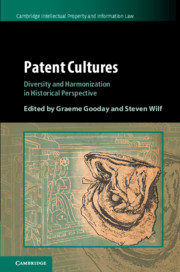Book contents
- Patent Cultures
- Cambridge Intellectual Property and Information Law
- Patent Cultures
- Copyright page
- Contents
- Figures
- Tables
- Contributors
- Preface
- Acknowledgments
- Note on the Cover Image
- Part I Introductory
- Part II Americas
- Part III Southern Europe
- Part IV Central and Eastern Europe
- Part V Asia
- 13 Patent Policy in India under the British Raj
- 14 The India Twist to Patent Culture
- 15 The Life and Times of Patent No. 2,670
- Part VI Epilogue
- Index
- Cambridge Intellectual Property and Information Law
13 - Patent Policy in India under the British Raj
A Bittersweet Story of Empire and Innovation
from Part V - Asia
Published online by Cambridge University Press: 23 March 2020
- Patent Cultures
- Cambridge Intellectual Property and Information Law
- Patent Cultures
- Copyright page
- Contents
- Figures
- Tables
- Contributors
- Preface
- Acknowledgments
- Note on the Cover Image
- Part I Introductory
- Part II Americas
- Part III Southern Europe
- Part IV Central and Eastern Europe
- Part V Asia
- 13 Patent Policy in India under the British Raj
- 14 The India Twist to Patent Culture
- 15 The Life and Times of Patent No. 2,670
- Part VI Epilogue
- Index
- Cambridge Intellectual Property and Information Law
Summary
Patents as “exclusive privileges” were introduced in India in 1856 when it was a colony of the British Empire. Many developed countries, then as now, used patent systems as policy levers to encourage importation and adoption of inventions in order to strengthen their technological capabilities. Yet even under the influence of British patent law, by the time of its independence in 1947 India was technologically far behind. This chapter examines this issue by focusing on patent policy and policy making in colonial India to highlight how colonial constraints on the political and legislative freedom of the Government of India had an adverse effect on choosing a patent policy conducive to India’s cultural interest. The analysis draws from the empirical evidence of inventors’ experiences of obtaining and enforcing patent rights in British India, and the role of various stakeholders in influencing the patent policy. It specifically outlines the case of patentees Messrs Thomson & Mylne, whose efforts led to the first large-scale commercialization of an Indian patent and reassessment of the proposed patent law vis-à-vis the needs of the Indian agricultural sector.
Keywords
- Type
- Chapter
- Information
- Patent CulturesDiversity and Harmonization in Historical Perspective, pp. 273 - 301Publisher: Cambridge University PressPrint publication year: 2020

